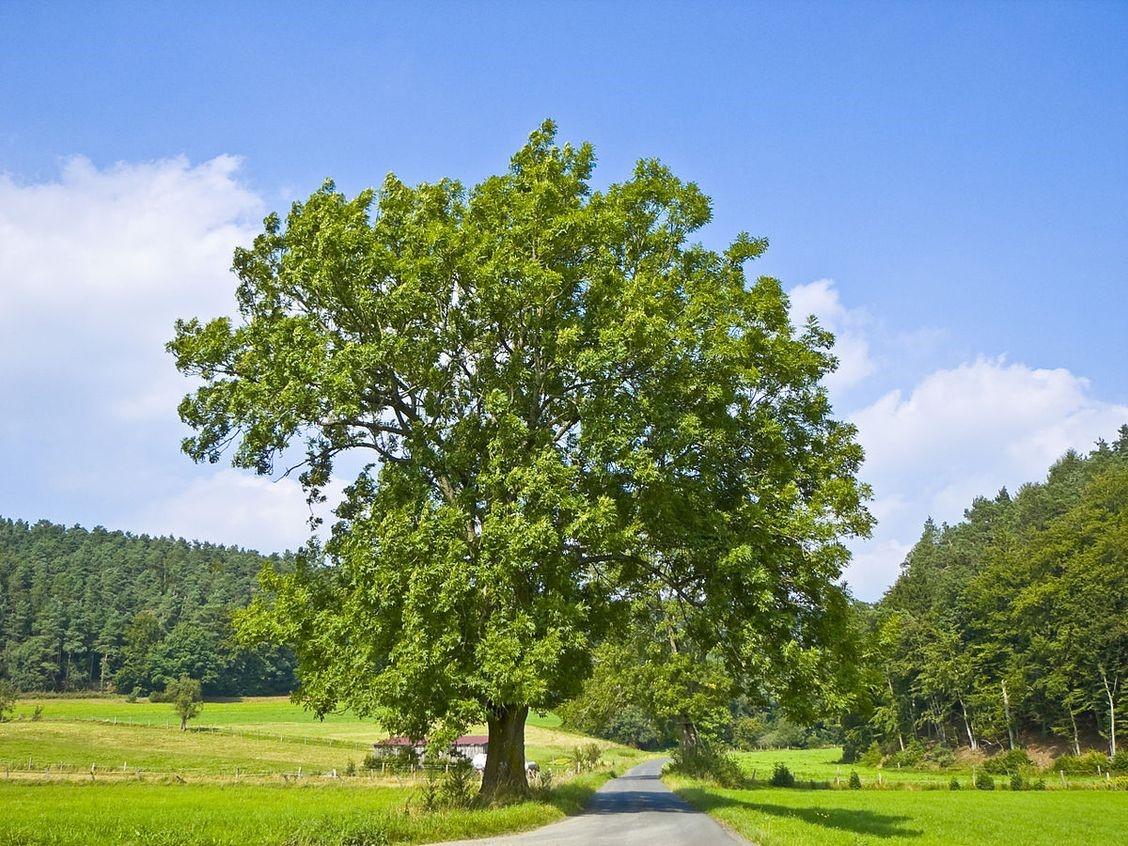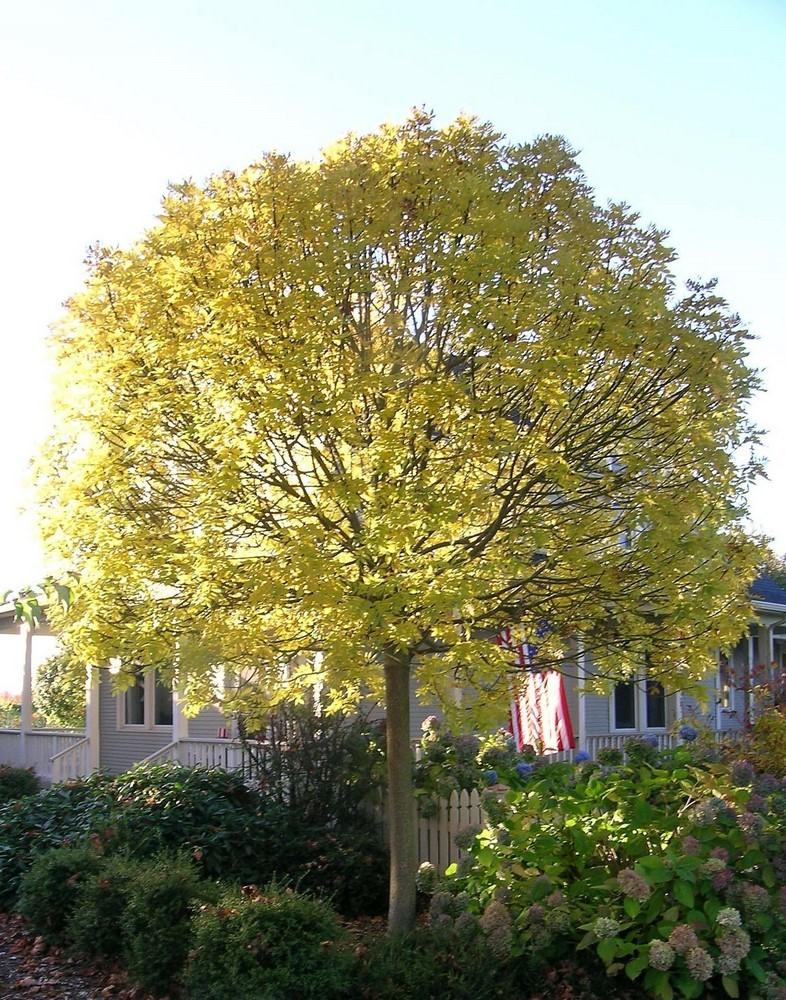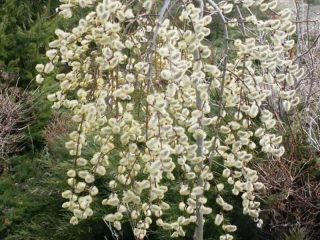Content
Russia is a country of forests. It contains a huge number of trees, the variety of species of which forces scientists to come up with new names for them. Among the most common is common ash, widely used in landscape design.
Description and characteristics of common ash
The plant is found in all corners of the planet. It belongs to the Olive family. The average life expectancy is 160 years, the maximum is 350 years.
Crown diameter and height of ash tree
The tree reaches about 28 m in height, although much taller specimens are found. The crown diameter of the common ash tree is 25-30 m. The plant is sometimes called “tall ash”. The crown is formed high from the ground and has an interesting shape. The barrel is quite strong. Reaches 1 m in diameter.

To protect the trunk from insects, whitewash is applied to the tree
What do ash leaves look like?
Common ash can be distinguished from other types of trees by the shape of its leaves. They are very large, reaching 35 cm in length. The arrangement of foliage is opposite. The veins are clearly visible on the leaf blade.If you look at them from below, you can discern a whitish tint.
Common ash forms leaves in May. The crown begins to fall off in September, the process may drag on until November. If the frost is severe enough, not only yellowed, but also green leaves fall off. But if the winter is expected to be mild, you can observe the yellowing process. This crown looks very beautiful.
What do ash fruits look like?
The fruit is a dry lionfish. They are usually called “helicopters” for their ability to rotate while falling. The fruits reach about 3-4 cm in length. At first they are green in color, but as they ripen they turn brown.
The common ash lionfish is essentially an oblong plate with a depression at the top. The plant reproduces by seeds. They are flat and dry to the touch. The fruits are collected in groups called panicles.

The tree's unripe panicles resemble miniature versions of bananas.
The fruiting period begins in September and ends in February or March. Birds love to feast on helicopters and wait until they fall to the ground. Lionfish are also eaten by rodents. The seeds it contains are very high in calories, as they mostly consist of fat.
Where does ash grow?
The tree covers a huge area. Common ash can be found in the North Caucasus, in the middle latitudes of Russia, in China, Korea, the USA, and Africa. It usually grows near oak and maple trees. The plant stands out in the fall when the leaves turn yellow.
It is believed that the tree first appeared in Transcaucasia.Forests consisting only of common ash are incredibly rare. Under natural conditions, the culture grows in almost all European countries, including the most northern ones.
Varieties of Ash
Common ash species are visible in the photo. There are four varieties:
- Summit. In Russia they are used exclusively for urban landscaping. The tree is characterized by a slender crown. High winter hardiness makes it easy to survive the Russian winter. Air pollution does not affect the health of the crop, so it is often found in the center of Moscow.
This variety looks quite “bare” compared to common ash
- Pendula. Due to the weeping branches, the plant looks like a willow. Ash develops at a high speed and tolerates frost well. Can grow near factories and roads. The tallest specimens grow in moist soils. Excess salt can cause death. This is a light-loving variety, however, at a young age it can grow in the shade.
The foliage of the tree is so dense that you can organize a house in it
- Crispa. Unlike common ash, the variety is undemanding to the soil. The only thing a tree needs is the frequency of watering. The plant loves a lot of light and is resistant to abundant moisture. Fungal diseases rarely bother him. The shoots are brown. The species is distinguished by its neatness, which is why it is widely used in decorating park areas.
The tree has rounded dark green leaves and a small trunk
- Nana. It has small dimensions, the shape of the crown is spherical. Grows slowly, prefers nutritious soil. He reacts harshly to excess moisture and does not like heat. Quite a demanding variety. The tree is placed in the shade.
The tree is notable for its large number of branches and leaves.
Planting and care
In order for the common ash tree to grow quickly and not experience problems with diseases, you need to choose the right location. The tree tolerates gases and acrid smoke well, and is not afraid of heavy precipitation or storms.
It is good if the area is open to sunlight. Common ash tolerates short-term drought. It is resistant to cold weather and can withstand temperatures down to -40 °C. The tree can be grown in any region of the country. There shouldn't be any special problems.
However, common ash is completely dependent on the soil in which it grows. It is better to choose low or medium acidity. Clay or sandy soils will be destructive for it. Particular attention should be paid to the amount of moisture. The tree may become diseased if it is overwatered frequently.
Seedlings need constant care. It is necessary to create a microclimate close to the native one. While the tree is young, water frequently. The soil is moistened strictly after drying, taking into account its drainage properties. Flooding must not be allowed.
The hotter the weather, the more common ash needs liquid. It is impossible to irrigate immediately after precipitation. The same applies to abnormal heat and strong winds. It is better to wait a few hours until the weather stabilizes.
Common ash needs liquid only in summer. If groundwater is located at a depth of up to 2 m, moisture should be minimal.

Under natural conditions the tree looks a bit like an oak
In the early stages of development, the crop needs fertilizers. For the first two years, additives are not added, since the seedling will have enough soil elements. In the third year, feed twice: in autumn and spring. In the first case, nitroammophoska is used, in the latter - nitrogen.
Common ash can be pruned. The plant is formed in the spring. The main thing is that by this moment it does not begin to bloom. Work is carried out from the bottom up. First, all weeds are removed, then the trunk is cleared to a height of 2.5 m.
How does ash reproduce?
Ash can be grown from seeds or using seedlings. Planting is carried out in favorable weather. The seeds must be fresh. This is usually done in August. The raw materials are buried in the ground at a distance of 4 cm.
A spacious hole is required for seedlings. It should be approximately 30% wider than the root shoots. After digging, drainage is formed. For this purpose, small stones and river sand are used. The planting hole is filled to a quarter of its entire volume. The rest of the space should be a nutrient substrate.
You can't leave any empty space. The tree trunk area is covered with a layer of mulch. This will allow the common ash tree to survive without moisture longer. Mulch is also useful for warming the root system.
Diseases and pests
Common ash has good immunity. Under unfavorable conditions, the tree may develop a fungal infection. It spreads at high speed, affecting first the roots, then the trunk and the entire crown.

The foliage of the tree is rarely red - this is explained by its special structure
Sometimes owners are faced with cytophomic cancer, which occurs due to insufficient hydration.To combat the infection, you need to remove damaged shoots and revise the watering schedule.
Another disease is infectious necrosis. The most obvious symptom is peeling of the bark. Common ash needs to be urgently treated with Bordeaux mixture or iron sulfate.
The plant can be attacked by pests. Of these, the most unpleasant is the ash beetle. It eats all the wood. If the insect is allowed to multiply, the ash tree may die. Insecticides are used to control the parasite.
Application of ash
In addition to paper production, common ash is actively used in landscape design. With its help you can decorate a park or garden in an original way. The tree is common in villages and villages. It provides fodder for livestock.

An example of a successful fence grown in a small American town
Common ash can often be found near roads. Its crown covers the roadway, protecting people from the cold. Living fencing also looks great in park areas. Botanists advise combining the crop with thorny bushes, oak, alder, and maple.
Conclusion
Common ash is one of the most common types of trees inhabiting the planet. The culture is unpretentious, but this means that its health can be neglected. Like any other living being, it gets sick and dies. Therefore, it is important to provide high-quality care and draw up a watering and fertilizing schedule.












